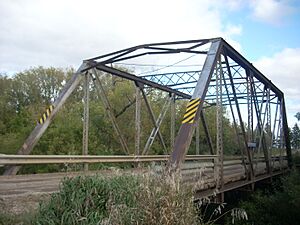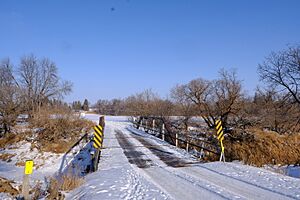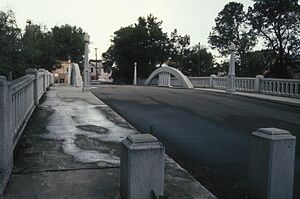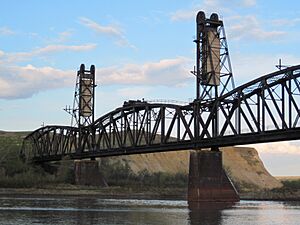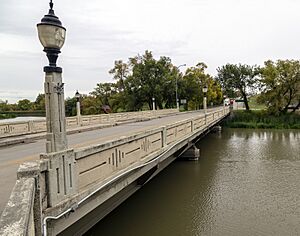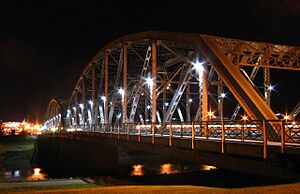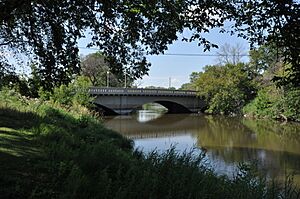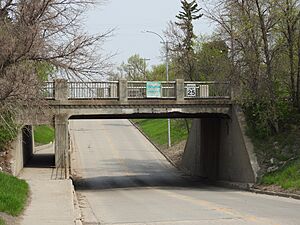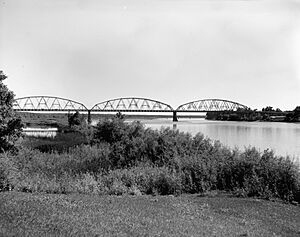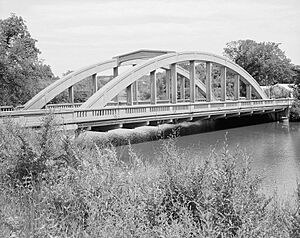List of bridges on the National Register of Historic Places in North Dakota facts for kids
Did you know that some bridges and tunnels are so special and old that they are protected by the government? In North Dakota, many amazing bridges and tunnels are listed on the National Register of Historic Places. This means they are important parts of history and need to be preserved for future generations to see and learn from.
These structures tell us stories about how people traveled and built things a long time ago. They show us clever engineering and design from the past. Let's explore some of these cool historic bridges and tunnels in North Dakota!
Contents
What is the National Register of Historic Places?
The National Register of Historic Places is like a special list of buildings, places, and structures in the United States that are important to history. When something is added to this list, it means it's recognized for its historical, architectural, or archaeological value. It helps protect these places so they don't get destroyed and can be enjoyed by everyone.
Historic Bridges of North Dakota
North Dakota has many bridges that are on this special list. Most of them are old bridges that helped people cross rivers and valleys long ago. They were built using different designs, which makes them unique.
Truss Bridges: Strong and Sturdy
Many of the historic bridges in North Dakota are called "truss bridges." A truss is a strong framework, usually made of triangles, that helps the bridge hold a lot of weight. Imagine a giant erector set!
One common type is the Pratt through truss. This design was very popular in the late 1800s and early 1900s. The main parts of the bridge go above the road, creating a tunnel-like feeling as you drive through.
Here are some examples of Pratt through truss bridges:
- Beaver Creek Bridge near Finley: Built in 1913.
- Caledonia Bridge near Caledonia: Built in 1895.
- Cedar Creek Bridge near Haynes: Built in 1908.
- Colton's Crossing Bridge near Lisbon: Built in 1907.
- Elliott Bridge near Towner: Built in 1902.
- Grace City Bridge near Grace City: Built in 1925.
- Knife River Bridge near Stanton near Stanton: Built by 1898.
- Nesheim Bridge near McVille: Built in 1904.
- Romness Bridge near Cooperstown: Built in 1912.
- Viking Bridge near Portland: Built in 1885 and 1915.
- Ost Valle Bridge near Thompson: Built in 1910.
Another type is the Pratt pony truss. In this design, the truss structure is shorter and doesn't go above the road. It's like a fence on the sides of the bridge.
- Northwood Bridge near Northwood: Built in 1906.
- Norway Bridge near Mayville: Built in 1912.
Other Cool Bridge Designs
Not all bridges are truss bridges! Engineers used many different ideas to build bridges that could handle rivers, trains, and cars.
- Crystal Bridge near Crystal: This bridge, built in 1927, is a concrete T-beam bridge. It uses strong concrete beams shaped like a "T" to support the road.
- Eastwood Park Bridge in Minot: Built in 1927, this is a cantilever type bridge. Cantilever bridges are built by extending sections outwards from supports, like a diving board.
- Fairview Lift Bridge near Cartwright: Built in 1913, this is a special railroad lift bridge. It can actually lift its middle section up to let boats pass underneath!
- Lisbon Bridge in Lisbon: Built in 1936, this is a steel cantilever beam bridge. It's similar to the Eastwood Park Bridge but made of steel.
- Midland Continental Overpass in Jamestown: Built in 1936, this is also a steel cantilever beam bridge.
- Midway Bridge near Johnstown: This bridge is a Warren Bedstead bridge. The "bedstead" part refers to its unique shape.
- New Rockford Bridge near New Rockford: Built in 1904, this is a Warren through truss bridge. It's similar to a Pratt truss but uses a different pattern of triangles. This bridge is now closed to traffic.
- Sorlie Memorial Bridge in Grand Forks: Built in 1929, this is a Parker through truss bridge. It's another type of truss bridge, named after its designer.
- West Park Bridge in Valley City: The original bridge, built in 1924, was a concrete false arch bridge. It looked like an arch but was supported differently. The original bridge was replaced in 2007.
Tunnels and Underpasses
Sometimes, instead of going over a river, a road or railway might go under something! These are called tunnels or underpasses.
- Great Northern Railway Underpass near Stanley: Built in 1937, this is a concrete deck girder bridge. Even though it's called a bridge, it acts like an underpass, allowing the railway to go over a road or another railway.
Bridges That Were Once Historic
Some bridges were once on the National Register of Historic Places but have since been removed. This can happen if a bridge is replaced, falls down, or is changed too much. Even if they are no longer on the list, they were still important parts of North Dakota's history!
Some examples of bridges that were removed from the list include:
- Blanchard Bridge near Blanchard: Built in 1900, removed in 2009.
- Goose River Bridge near Hillsboro: Built in 1893, removed in 2009.
- Liberty Memorial Bridge in Bismarck: Built in 1920-1922, removed in 2009. This was a large Warren-Turner through truss bridge.
- Porter Elliott Bridge near Hillsboro: Built in 1902, removed in 2009.
- Portland Park Bridge near Portland: Built in 1919, removed in 2004.
- Rainbow Arch Bridge in Valley City: Built in 1925, removed in 2004. This was a unique Marsh Rainbow Arch bridge.
These historic bridges and tunnels are like open-air museums, showing us how people built things in the past and how important these structures were for connecting communities and helping people travel across North Dakota.
Images for kids


